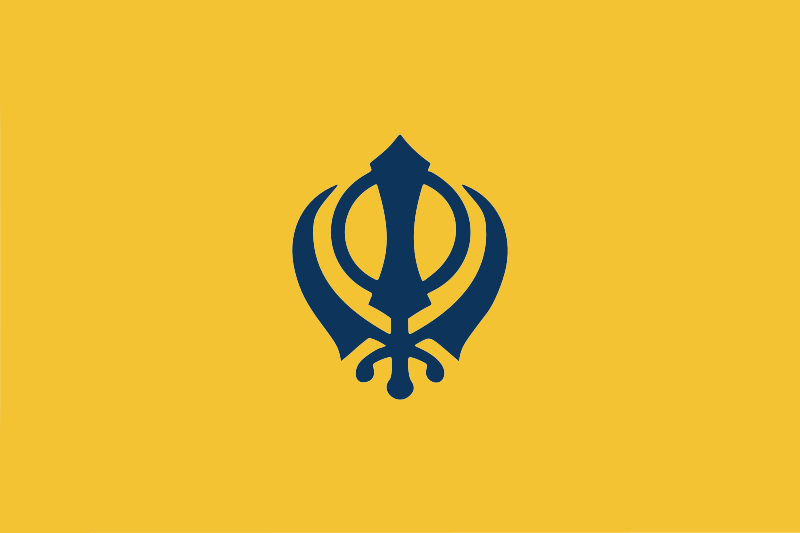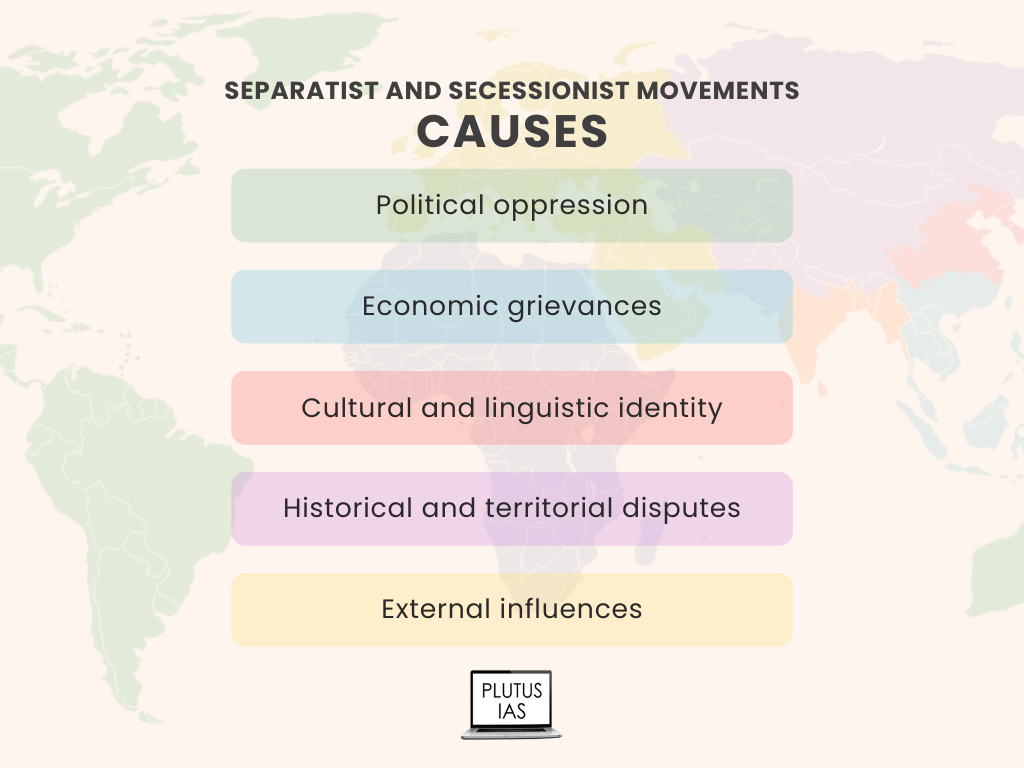27 Feb Khalistan Issue
Khalistan Issue
This article covers “ Daily Current Affairs” and the topic details how Amrit Pal Singh, a pro-Khalistani Sikh Leader is trying to revive the Khalistan issue again. After the stern action taken by the Indian Government in the past, the movement had lost its momentum. The current developments are showing an upward trend to bring the dormant issue to the political center stage.
The topic is important because any such separatist or secessionist movement has a direct impact on the internal security of India.

Khalistan flag
The Proposed Flag of Khalistan. It is often used for political mobilization for the movement.
For Prelims
Geographical features of Punjab – Rivers, Neighboring states, etc.
Facts about Maharaja Ranjit Singh, Anglo-Punjab Wars, etc.
For Mains
GS 3, Role of external state and non-state actors in creating challenges to internal security.
- Meaning of State and Sovereignty.
- List of secessionist movements in the past.
- Causes of separatist/ secessionist movements.
Government policy and previous experiences in dealing with separatist/ secessionist movements.
Content of the Article:
- Why in news
- Introduction
- What are the causes of Separatist or Secessionist Movements?
- How has been the experience of the Indian government in dealing with separatist tendencies across the country?
- Historical Background of the Khalistan Movement
- Indian Government Policy about the Khalistan issue
- Way Forward
Why in news:
Recently, armed supporters of self-styled Sikh preacher and pro-Khalistan propagator Amritpal Singh indulged in a scuffle with Punjab police personnel. A few policemen were hurt. Singh, who heads the radical ‘ Waris Punjab De’ outfit, has been speaking the language of secession and separatism, evoking calls for the freedom of Punjab and the creation of Khalistan.

Khalistan movement
Introduction
The Khalistan movement is a separatist movement that emerged in the 1980s and seeks to create a separate homeland for Sikhs in the Punjab region of India. The proposed state, called Khalistan, would consist of parts of Punjab, neighboring states (Himachal Pradesh, Haryana & Rajasthan ), and Lahore in Pakistan. The movement envisages Lahore to be the capital of Khalistan.
The demand for Khalistan emerged in response to what some Sikhs perceived as the marginalization and discrimination of the Sikh community in India. However, the Indian government launched a crackdown on the movement, and most of the militant groups were dismantled by the mid-1990s. Since then, the demand for Khalistan has lost momentum, and the majority of Sikhs in India do not support it, barring some occasional voices.
What are Separatist or Secessionist movements?
These are political movements that aim to establish a separate independent state within a region or territory that is currently part of a larger state. Such movements are usually driven by a desire to address political, cultural, linguistic, or economic grievances and to gain greater autonomy or self-determination for the region in question. The residents often feel a sense of relative deprivation which is exploited politically by leaders. Examples of separatist or secessionist movements around the world include the Basque separatist movement in Spain, the Tamil separatist movement in Sri Lanka, the Chechen separatist movement in Russia, the Kurdish separatist movement in Turkey, and the Quebec separatist movement in Canada.
What are the causes of Separatist or Secessionist Movements?
There are various causes of separatist movements, and they can vary depending on the specific region and context. Here are some common factors that can contribute to separatist movements:

Khalistan issue
- Political oppression: Discrimination, marginalization, and oppression of a particular group by the state or dominant group can lead to feelings of disenfranchisement and a desire for autonomy or independence.
- Economic grievances: Unequal distribution of resources and economic disparities can fuel demands for greater economic control and self-determination.
- Cultural and linguistic identity: The desire to protect and promote a unique cultural or linguistic identity can lead to calls for greater autonomy or even independence.
- Historical and territorial disputes: Historical claims to a particular region, border disputes, or territorial grievances can fuel separatist movements.
- External influences: External actors, such as neighboring countries or diaspora communities, can influence and support separatist movements in a particular region.
How has been the experience of the Indian government in dealing with separatist tendencies across the country?
Secession and separatist tendencies are considered illegal in India. Traditionally, the Indian government has adopted a zero-tolerance policy toward any attempt to break the country. Any individual or group advocating for secession or separatism may face legal consequences.
The Indian government has had mixed experience in dealing with secessionist and separatist movements in different parts of the country. Allowing a mixed approach, It has given room to separatists to voice their grievances and at the same time has also dealt with them with an iron hand in other cases. A range of measures like negotiation, force, and development initiatives are adopted.
In some cases, the government’s handling of separatist movements has been successful. For example, the government has been able to resolve the Bodo separatist movement in Assam through negotiations and the creation of an autonomous council. Similarly, the Mizoram separatist movement was resolved through negotiations and a peace accord that granted greater autonomy to the region.
However, in other cases, the government’s approach has been strict and has been criticized for being heavy-handed. There are allegations of excessive use of force which has led to further exacerbating the tensions. For instance, the government’s handling of the Kashmir separatist movement has been controversial, with accusations of human rights abuses by security forces and allegations of lack of political engagement.
Similarly, in dealing with the Khalistan movement in the 1980s and 1990s, the government’s approach was characterized by a hash military crackdown that led to a period of violence and unrest in Punjab. While the situation in Punjab has since stabilized, the use of force has been criticized for exacerbating tensions and leading to further violence.
In a nutshell, the Indian government’s experience in dealing with separatist movements has been mixed, and there is a need for a nuanced and comprehensive approach that takes into account the grievances of the affected communities while ensuring the integrity and unity of the country. Political dialogue at the highest is the key.
The idea of Khalistan, a separate Sikh homeland, has
The historical Background of the Khalistan Movement
been a controversial topic for decades, particularly in India. Here is a brief timeline of some significant events related to Khalistan:
1947: India gained independence from British colonial rule and is partitioned into two countries, India and Pakistan.
1966: The state of Punjab is divided into three parts, with the Hindi-speaking areas forming the new state of Haryana, and the Punjabi-speaking areas being divided between Punjab and the new state of Himachal Pradesh.
1973: The Anandpur Sahib Resolution was passed by the Shiromani Akali Dal, a political party representing Sikhs in Punjab, calling for greater autonomy for Punjab and recognition of the Sikh religion.
1980: The Khalistan movement gained momentum as some Sikhs demand a separate homeland for themselves, citing discrimination and economic hardship.
1982: Jarnail Singh Bhindranwale, a militant Sikh leader, took over the Golden Temple complex in Amritsar and declared it to be the seat of Khalistan.
1984: In June, the Indian government launched ‘Operation Blue Star’ to flush out Bhindranwale and his followers from the Golden Temple complex. The operation resulted in a military siege of the temple and the deaths of hundreds of people, including Bhindranwale.
1984: In October, Indian Prime Minister Indira Gandhi was assassinated by her Sikh bodyguards in retaliation for ‘Operation Blue Star’. This led to widespread anti-Sikh riots in which thousands of Sikhs were killed in Delhi and other parts of India.
1985: The Punjab Police and other security forces began a crackdown on Sikh militants, leading to a period of violence and terrorism in Punjab.
1992: The Khalistan movement lost momentum as many of its leaders were arrested or killed by security forces.
1995: The Punjab state government signed the Punjab Accord, which granted greater autonomy to the state and promised to address some of the grievances of Sikhs.
2002: The Khalistan movement became largely dormant, though some Sikh activists continue to call for a separate homeland.
Indian Government Policy about the Khalistan issue
The Indian government’s policy on the Khalistan issue has been focused on maintaining the territorial integrity and unity of India. The government has consistently rejected demands for a separate Sikh homeland and has taken a hardline stance against any separatist or secessionist movements.
Currently, the Indian government remains committed to maintaining peace and stability in Punjab and other parts of the country affected by separatist movements. It has implemented measures such as increased security and surveillance to prevent and counter any separatist activities. The government also continues to engage with Sikh community leaders and political parties to address their concerns and grievances within the framework of the Indian Constitution.
Way Forward for the Khalistan movement
The way forward for the Khalistan movement is a complex issue, and there is no one-size-fits-all solution. However, here are some possible ways forward that could be explored:
- Political engagement: The Khalistan movement leaders could engage in political dialogue with the Indian government to address their grievances and demands within the framework of the Indian Constitution. This could involve negotiations on issues such as greater autonomy for Punjab, sharing of river waters, and distribution of central funds. But, the caveat is to engage and recognize only those sections that have genuine demands.
- Focus on development: The Indian Government could focus on development initiatives for Punjab and its people, such as education, healthcare, and infrastructure. This could help address some of the underlying grievances of the movement.
It’s important to note that any way forward for the Khalistan movement should be peaceful, and democratic and must follow rule of law. Outright violence on the part of Khalistani leaders and total intolerance on part of the Indian government can only complicate the issue. Thus, political dialogue, the formation of a comprehensive policy, and a focus on development initiatives should be the way forward.
Source:
Daily Current Affairs for UPSC
The topic of daily current affairs illustrates the issue and movement of Khalistan in India. The UPSC aspirants get all the last and the best daily current affairs for the UPSC examination from Plutus IAS. They can also collect weekly and monthly current affairs for the IAS exam preparation. By reading these current affairs The aspirants not only enhance their general knowledge but also complete the UPSC syllabus.



No Comments